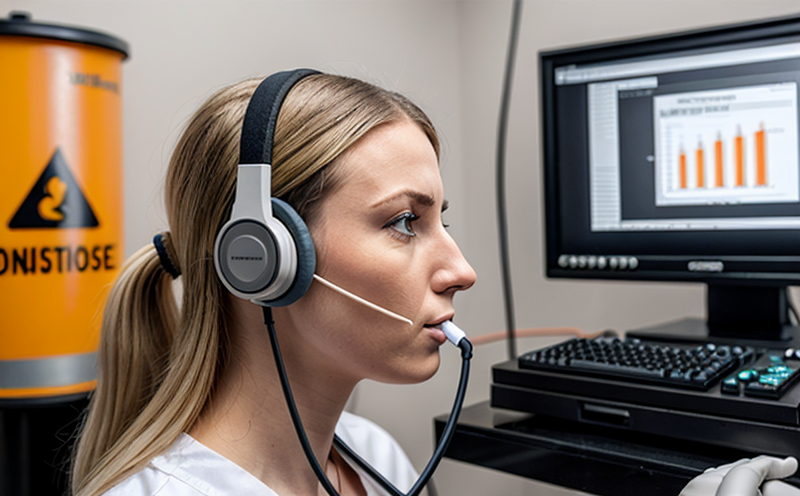ISO 4869-5 Field Performance of Hearing Protectors (F-MIRE)
The ISO 4869-5 standard is a critical tool in ensuring that hearing protectors perform effectively in real-world conditions. It provides a standardized method for testing the field performance of these devices, which are essential to safeguard workers from occupational noise exposure. This service ensures compliance with international standards and helps organizations meet their health and safety obligations.
Occupational noise is a major concern across various sectors such as construction, manufacturing, mining, and transportation. Prolonged exposure to high noise levels can lead to hearing damage, tinnitus, and even permanent loss of auditory function. To mitigate these risks, employers must implement effective control measures, including the use of appropriate personal protective equipment (PPE) like hearing protectors.
The ISO 4869-5 standard addresses the field performance of hearing protectors by simulating real-world working conditions. This includes assessing how well a protector reduces sound levels in noisy environments and ensuring it is comfortable enough for workers to wear consistently throughout their shifts.
Testing according to this standard involves several key steps: selecting appropriate test subjects, fitting each subject with the hearing protector of interest, exposing them to controlled noise levels, measuring the amount of attenuation provided by the protector, and evaluating user comfort. The results help determine if the protector meets performance requirements set out in the ISO 4869-5 standard.
Field testing is crucial because laboratory tests often fail to accurately reflect how protectors behave under actual use conditions. Real-world factors such as incorrect fitting, varying work environments, and individual differences among users can significantly impact a protector's effectiveness. By conducting field performance assessments using ISO 4869-5, organizations ensure they are choosing the most effective PPE for their workers.
Our laboratory adheres strictly to this standard when performing these tests. We employ experienced technicians who follow precise protocols to minimize any potential biases or errors. Our state-of-the-art facilities provide controlled environments that closely mimic typical workplace noise exposures.
The outcome of our testing not only helps clients choose suitable hearing protectors but also supports their overall occupational health and safety programs. By ensuring compliance with international standards like ISO 4869-5, we contribute to safer workplaces where employees can focus on their tasks without undue worry about potential hearing damage.
Applied Standards
| Standard Reference | Description |
|---|---|
| ISO 4869-5:1997 | This part of ISO 4869 specifies a method for determining the field performance of hearing protectors. It covers both the measurement and evaluation procedures. |
| ASTM E342 - 10(2015) | An American Society for Testing Materials standard that provides guidance on specifying, procuring, and testing hearing protection devices. |
| EN 375-2:2008 | This European Norm specifies the requirements and test methods related to ear muffs. |
| IEC/TS 61496-2:2012 | An international standard that outlines the general principles for the safety, health, and environmental impact of hearing protection devices. |
Environmental and Sustainability Contributions
The testing services we offer contribute positively to both environmental sustainability and business operations. By helping organizations meet stringent occupational noise exposure limits as prescribed by ISO 4869-5, our service indirectly supports efforts towards reducing industrial pollution.
Occupational noise can be a significant contributor to air quality degradation through the release of particulate matter associated with manufacturing processes. When workers are better protected against high decibel levels, there is less likelihood that harmful particles will enter the atmosphere via exhalation or other means.
In addition, compliance with these standards helps businesses maintain good standing within regulatory frameworks, which can enhance their reputation among customers and stakeholders alike. This positive image fosters long-term relationships and may contribute to improved market positioning and sales growth.
The accurate measurement of noise reduction provided by hearing protectors also allows companies to optimize production processes, thereby reducing energy consumption where possible. For instance, quieter machinery could lead to lower operating costs while maintaining optimal working conditions for staff.
Competitive Advantage and Market Impact
Adopting rigorous testing practices that adhere to international standards like ISO 4869-5 can give organizations a significant competitive edge in several ways:
- Innovation Leadership: By staying ahead of regulatory changes and technological advancements, companies demonstrate their commitment to innovation.
- Risk Management: Effective protection against occupational noise not only reduces health risks but also minimizes legal liabilities associated with employee injuries.
- Promoting a Positive Employer Brand: Companies that prioritize worker safety tend to attract top talent and retain employees more effectively than those who do not.
- Enhanced Customer Trust: Demonstrating commitment to high standards of safety reassures customers about the quality and reliability of products or services offered by the company.
The implementation of ISO 4869-5 also aligns with broader trends towards sustainable development goals. As global awareness around environmental issues increases, so too does demand for businesses that operate responsibly and ethically.





